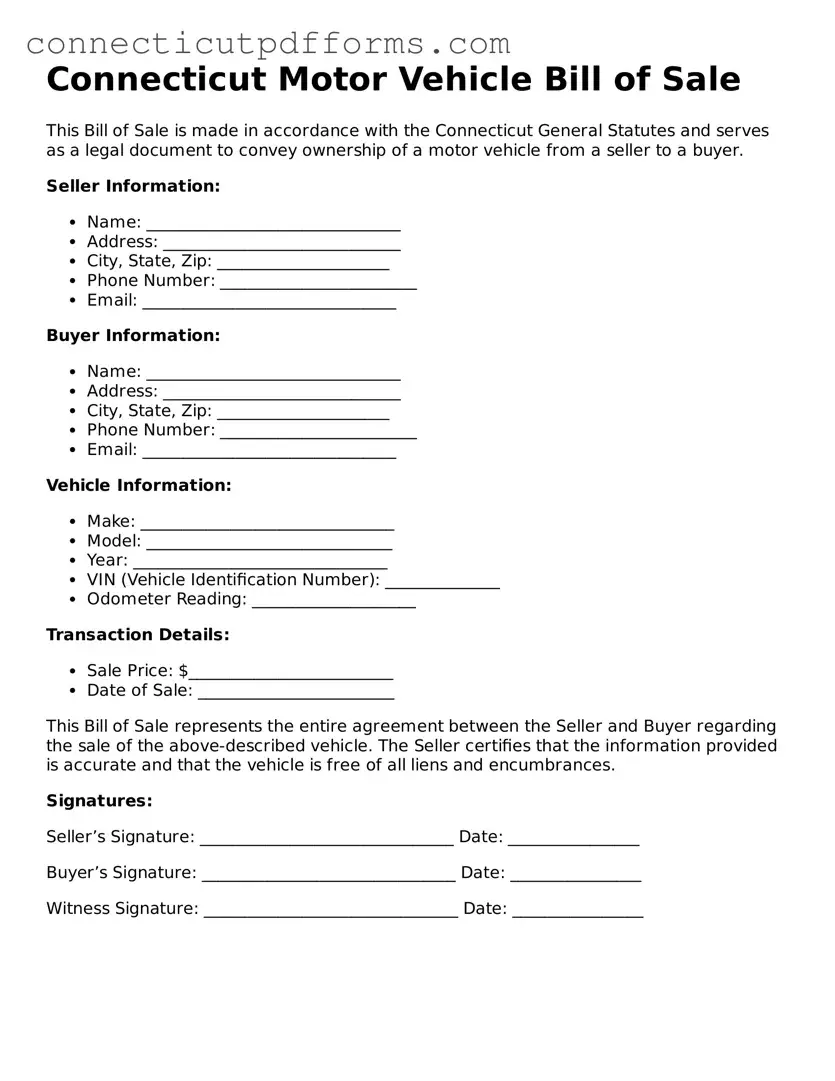The Connecticut Motor Vehicle Bill of Sale form is akin to a general Bill of Sale, which serves as a written record of a transaction between a buyer and a seller. This document outlines the details of the sale, including the item being sold, the purchase price, and the date of the transaction. Just like the Motor Vehicle Bill of Sale, a general Bill of Sale can be used for various items, such as furniture or electronics, and it provides legal protection for both parties by documenting the transfer of ownership.
Another similar document is the Vehicle Title Transfer form. This form is specifically designed to transfer ownership of a vehicle from one party to another. While the Motor Vehicle Bill of Sale provides proof of the transaction, the Vehicle Title Transfer is essential for updating the official records with the state. Both documents are critical in ensuring that the new owner has clear title to the vehicle and that the previous owner is no longer liable for it.
The Purchase Agreement is another document that shares similarities with the Motor Vehicle Bill of Sale. This agreement outlines the terms and conditions of a sale, including payment methods, warranties, and contingencies. While the Bill of Sale serves as a simple receipt, a Purchase Agreement can be more detailed and may include additional clauses that protect both the buyer and seller. Both documents aim to clarify the expectations of both parties involved in the transaction.
In addition, the Odometer Disclosure Statement is closely related to the Motor Vehicle Bill of Sale. This form is often required when selling a vehicle to ensure that the buyer is informed about the vehicle's mileage at the time of sale. Like the Bill of Sale, this document helps prevent fraud and ensures transparency in the transaction. Both documents work together to provide a complete picture of the vehicle's history and condition.
The Affidavit of Ownership is another document that can be compared to the Motor Vehicle Bill of Sale. This affidavit is used when a seller cannot provide a title for the vehicle, often due to loss or theft. It serves as a sworn statement affirming that the seller is the rightful owner. While the Motor Vehicle Bill of Sale confirms the sale, the Affidavit of Ownership provides additional assurance regarding the seller's claim to ownership.
The Receipt for Payment is also similar in function to the Motor Vehicle Bill of Sale. This document serves as proof that a buyer has paid for the vehicle. While the Bill of Sale details the sale transaction, a Receipt for Payment confirms that the financial aspect has been settled. Both documents are essential for record-keeping and can be used as evidence in the event of a dispute.
In the realm of vehicle transactions, ensuring clear documentation is paramount, and one valuable resource for this purpose is the Templates and Guide, which offers essential templates for navigating the complexities of sales and ownership transfer paperwork.
The Release of Liability form is another important document related to the sale of a vehicle. This form notifies the state that the seller is no longer responsible for the vehicle once it has been sold. It is crucial for protecting the seller from any future liabilities associated with the vehicle. Similar to the Motor Vehicle Bill of Sale, this document helps ensure that both parties are protected during and after the transaction.
Lastly, the DMV Registration form is comparable to the Motor Vehicle Bill of Sale in that it is necessary for legal ownership of a vehicle. After a sale, the new owner must register the vehicle with the Department of Motor Vehicles. This form requires information about the vehicle and the new owner, and it is essential for updating state records. Both documents play a vital role in the process of transferring ownership and ensuring that the vehicle is legally recognized under the new owner's name.
